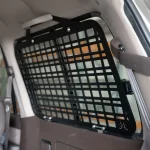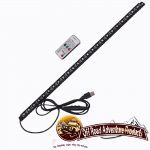[vc_row no_margin=”true” padding_top=”20px” padding_bottom=”0px” border=”none”][vc_column width=”2/3″][text_output]
Most engine temperature gauges and protection systems will not detect loss of coolant fluid. This is because the gauges and temperature switches rely on sensing the coolant temperature and when there is no coolant, the gauges cannot sense the temperature.
[/text_output][share title=”Like this post? Please share” facebook=”true” twitter=”true” google_plus=”true” linkedin=”true”][text_output]
Some engines have the water pump mounted so high that even a little coolant loss can result in the pump running dry causing major damage to the engine.
When off roading the radiator core can be damaged by by debris being bounced up or from bottoming out on a rock. If the stress fractures are large enough the sudden water loss may occur in the radiator leading to loss of coolant .
[/text_output][/vc_column][vc_column width=”1/3″][recent_posts type=”post” count=”2″ orientation=”vertical” fade=”true”][/vc_column][/vc_row][vc_row no_margin=”true” padding_top=”0px” padding_bottom=”0px” border=”none”][vc_column width=”1/4″][image type=”rounded” float=”left” info=”none” info_place=”top” info_trigger=”hover” src=”70064″][/vc_column][vc_column width=”3/4″][text_output]In this scenario, the vehicle is at risk of the coolant loss being fast enough to prevent the temperature gauge from working correctly. You may not even know your engine is in trouble until it is too late.
The REDARC low coolant alarm will provide an early warning that a vehicle has low coolant levels. It is a cheap insurance against the significant costs that can arise from an engine overheating. The product has a number of smart features including a delay to prevent false alarm from coolant slosh when off road.
If the radiator is not quite full, the LED flashes after 1⁄2 a second (but the audible alarm will not turn on for 3-4 seconds) therefore you will have a visual reminder to top up.[/text_output][/vc_column][/vc_row][vc_row no_margin=”true” padding_top=”0px” padding_bottom=”0px” border=”none”][vc_column width=”2/3″][rev_slider_vc alias=”redarc”][/vc_column][vc_column width=”1/3″][text_output]Download the Redarc LSA1224 fitting instructions here[/text_output][button shape=”pill” size=”mini” float=”none” circle=”true” info=”none” info_place=”top” info_trigger=”hover” href=”http://www.redarc.com.au/images/uploads/images/LCA1224_Instruction_Sheet.pdf” title=”Download”]Click here to download[/button][/vc_column][/vc_row][vc_row][vc_column width=”1/1″][text_output][pullquote cite=”” type=”left, right”]
About REDARC
Over the last three decades our company has established a reputation as the power conversion specialist.
A 100% Australian-owned company, we have met the needs of customers in transport and other industries through exciting, innovative thinking. We believe in total customer satisfaction and practice this by offering our customers:
- Technical advice free of jargon and free of charge
- Prompt turnaround of orders throughout Australia and globally
- Friendly, personalised, professional service and product supportIn the unlikely event that a technical issue arises with a Redarc product, customers are encouraged to initially contact the Redarc Technical Support Team on (08) 8322 4848 or power@redarc.com.au for prompt and efficient diagnosis and product support.
[/pullquote]
HOT TIP!
Redarc technicians are regularly asked about how to fit the temperature probe into a plastic header tank. Their ideal solution is not only limited to plastic header tanks.
If fitting the LCA1224 probe to the top tank is not suitable, an alternative is to install a stainless steel bolt in the top radiator hose. Additional parts required (all stainless steel):
- Bolt (M5x20 is a good choice)
- Two flat washers, spring washer and two nuts to suit
- Lug to fit on the bolt, crimped on to the
- LCA1224 blue wire
Instructions:
- When the radiator is cool, remove the radiator cap and drain some coolant to lower the level
- Remove top radiator hose (it may only be necessary to remove one end)
- Drill or punch a hole in the hose (e.g. 4mm so it is a tight fit for the bolt). The hole should be close enough to the radiator end to be reached but not close enough to contact the pipe when it is put back in place 4 Place a flat washer on the bolt & push the bolt/washer through from the inside of the hose (hopefully you can reach the hole to do this if step 3 was followed)
- Place the other flat washer and a spring washer on the bolt outside the hose
- Place the first nut on the bolt and tighten sufficiently to seal the hose between the two washers without crushing/splitting the hose
- Place the crimped lug with the blue wire on the bolt & secure with the second nut (using a “Nyloc” nut will give better security)
- Replace and clamp hose
- Top up coolant
- Test run and check for leaks
[/text_output][/vc_column][/vc_row]




